Glossary
A | B | C | D | E | F | G | H | I | J | K | L | M | N | O | P | Q | R | S | T | U | V | W | X | Y | Z
Aggregate—Crushed stone or gravel used as a base course for riprap, asphalt, or concrete pavement. Aggregate is also used in asphalt and concrete mixes.
Asphalt—A mixture of aggregate and asphalt cement, correctly called asphaltic concrete.
Baluster—One of many vertical pieces between the top and bottom rails of a guardrail.
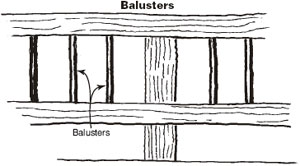
Batter, battering—Sloping the exposed face of a wall back either at a uniform angle, or stepping it back uniformly, the structurally sound way to build a timber wall.
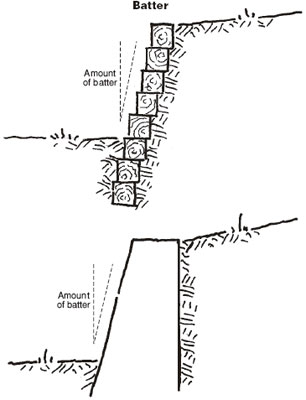
Bevel—Finishing the corner of a piece of lumber by removing a narrow portion of wood at a uniform angle to the edge and face. A bevel follows the grain of the wood (see chamfer).

Borrow pit—An excavation used to obtain fill for a construction site.
Braided trails—Parallel trails around a low, wet spot. These trails are not constructed, but are worn in the ground by trail users who do not want to get their feet wet or walk in mud. Each new trail funnels water to a low point. Users repeat the process, producing a series of trails.
Camber—A slight bend in a timber.
Cantilever—The portion of a beam or plank extending beyond one or both of its supports.

Chamfer—Similar to a bevel but done at the end of the piece of wood and across the grain.
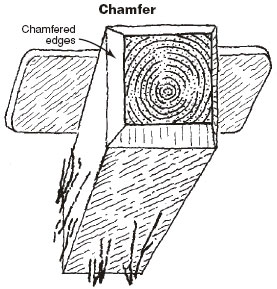
Concrete—A mixture of sand, coarse aggregate (crushed gravel or crushed stone), portland cement, and water correctly called Portland cement concrete. The wet mixture is placed in a form or trench and dries to a hard material.
Control points—Natural, recognizable features on the site or a series of survey stakes used to establish distances and elevations during trail construction.
Countersinking—Drilling a wide, shallow hole in a piece of wood for a washer and nut or for the head of a bolt or screw. Countersinking allows the hardware to be recessed below the surface of the wood. Countersinking reduces the amount of treated wood and will accelerate decay if the hole is exposed to moisture.

Course—A single layer of building material of a uniform height. The material is placed one layer (or course) at a time on top of another layer (or course). Materials laid in courses include bricks, concrete blocks, timbers, and logs.
Crook—A defect in a log caused by a crooked tree.
Cross slope or cross pitch—The amount a surface slopes, measured perpendicular to the centerline of a road or trail.
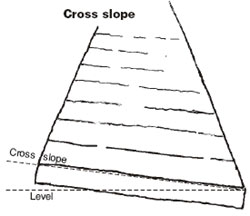
Crown—The branches, twigs, and leaves of a tree. Also a paved surface that is higher in the center than at the edges.
Cupped, cupping—A board or plank whose edges are higher or lower than the center. Cupping is often found in decks, where the board edges are higher than the middle. Water, trapped in the cupped area, accelerates decay.

Curb—A wood, concrete, or stone trail component that rests on the ground or on the trail tread, rising 2 to 8 inches above the trail tread.
Dap—A shallow hole or slot drilled or routed in a piece of wood. A dap is usually drilled to fit over a piece of hardware (a nut, the head of a bolt, or a portion of a steel plate or angle) that is connected to an adjacent piece of wood.
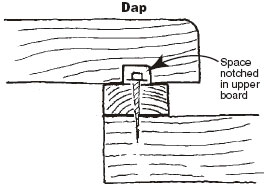
Deadman—A log or logs, heavy timber or timbers, a large block of concrete, a large boulder, or combination of the above that is partially or completely buried. Eyebolts placed in deadmen are used to anchor cables. Log or timber deadmen (without eyebolts) are used in log or timber retaining walls. They are placed perpendicular to the face of the wall, extending into the earth behind it to prevent the wall from falling over.

Destination trail—A trail route that starts at a trailhead and ends at a point of interest, the destination. The trail user returns by the same route.
Driftpin—A piece of 12- to 30-inch rebar or steel pipe used to keep logs and timbers in place.
Fisherman's knot—A knot used to tie a rope sling for moving logs and timbers. A single length of rope is tied into a loop using two overhand knots tied in each end of the rope and around the opposite end.
Footing—The part of a structural foundation that rests on the ground, spreading the weight of the structure and supporting the structure above. Footings are usually concrete. At remote sites the footings may also be mortared stone masonry.

Froe—An old handtool used originally for splitting shingles and shakes. The froe consists of a heavy, 12-inch-long, straight steel blade with a wooden handle. The cutting edge of the blade is placed against the wood to be cut and a club or mallet is used to hit the face.
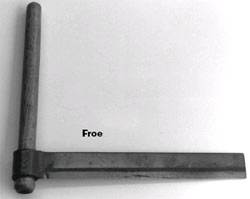
Frostline—The maximum depth that frost can be expected to penetrate into the ground.
Glulaminated—A process used to fabricate long beams from short lengths of 2 by 4, or 2 by 6, or 2 by 10 lumber. The pieces are placed flat on top of each other with glue spread between them. Lengths are varied so that transverse joints in each layer are not opposite one another. Pressure binds the pieces together. The assembly may be two to four times longer than the longest individual piece of lumber within it.
Grade—The rate of climb or descent along the centerline of a trail. It is described as a percentage and expressed as the number of units of climb or descent per 100 units of horizontal distance. A +5-percent grade rises 5 feet in 100 feet, or 5 meters in 100 meters. A -2-percent grade descends 2 feet per 100 feet (or 2 meters per 100 meters). The plus symbol indicates climb. The minus symbol indicates descent.
Groundwater—Water contained in the soil a few inches to several feet below the surface of the ground. In wetlands, the depth to groundwater is often higher in winter and spring and lower in summer and fall.
Guardrail—A railing at the edge of a deck to prevent people from falling. A guardrail should be 36 to 42 inches above the deck.
Handrail—A railing along a stairway to help people avoid falling down the stairs. A handrail should be 32 to 35 inches above the stairs.
Hardwood/softwood—Inaccurate logger's terms that have nothing to do with how hard or soft the wood is. By the logger's definition, hardwoods are deciduous trees with broad leaves and softwoods are conifers with needles. Aspen and red maple are "hardwoods," but their wood is soft; Douglas-fir and Atlantic white cedar are "softwoods," but their wood is hard. Some hardwoods, such as live oak and southern magnolia, keep their leaves through the winter. Some "softwoods," such as larch and baldcypress in the northern portion of its range, lose their needles in the fall.
Heartwood—The oldest wood of a tree, extending from the center of a log to the sapwood. The heartwood is the densest, strongest, and darkest wood in a log.

Helical pile—A solid steel shaft 1½ to 2½ inches square with a series of steel helixes welded to the shaft. The helixes are similar to threads on a bolt or the threads on a powered earth auger. The smallest helical piles or screw piles are 6 inches in diameter and 30 inches long. A machine screws them into the ground.
Hewing—Using an ax or adz to cut a log so that its cross section is a square or rectangular.
Hummocky—Wetland terrain containing hummocks, ridges, and small mounds of earth 2 to 4 feet higher than the surrounding area.
Invert—The bottom surface of a pipe, ditch, or culvert over which water flows.
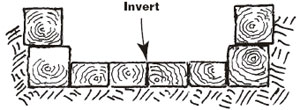
Joist—Usually a wooden 2 by 6, 2 by 8, 2 by 10, or 2 by 12, with the 2-inch dimension resting on a sleeper (sill) or ledger, toenailed into place, supporting a floor or deck.
Joist hanger—A steel angle or strap nailed to the side of a ledger and shaped to hold a joist. If a top flange hanger or face mount hanger is installed, the joist is placed within the hanger and the two are nailed together.
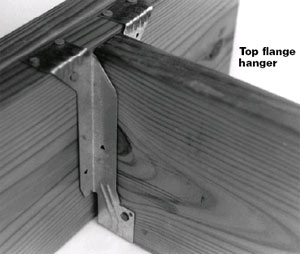
Ledger—A horizontal piece of wood attached to, and supported by, piles or concrete or stone masonry piers. The ledgers support stringers or tread timbers.
Log dogs—The first type of log dog is a broad U-shaped steel bar 18 to 30 inches wide, with pointed ends, which is used to temporarily hold two logs at right angles to each other. The second type of log dog is smaller and easier to pack. It consists of a 6-inch to 12-inch-long steel plate that is 2 to 3 inches wide and pointed at each end. A second steel plate (3 to 6 inches long, identical width, pointed at one end and straight on the other) is welded across the center of the first to form a T.

Loop trail—A trail route that forms a closed circuit connecting a number of points of interest. The trail returns to the trailhead where it began but the trail user does not cover the same route twice.
Lumber—As used in this text, wood that has been sawed into a square or rectangular cross section that is 2 inches thick or less.
Moraine—Moraines are made of debris deposited by glaciers. The most common moraines are end (or terminal) moraines and lateral (or slide) moraines. Rock that the glacier has broken out of the valley is deposited in the moraines. Rock in moraines has been broken up and ground into boulders and various sizes of gravel and sand.
Mortar—A mixture of sand, lime, Portland cement, and water. Mortar is used in masonry construction to bind bricks, concrete blocks, or stone to form structural elements such as retaining walls and piers. Mortar may also be used when constructing riprap.
Nailer—A strip of wood attached to a stringer that tread planks are nailed or screwed to.

Peen—To strike a piece of metal with a hammer, denting the surface, or mashing the threads of a bolt after installing a nut, to prevent the nut from being removed.
Pier—Piers are used to support one or both ends of a beam or stringer. Piers may be timber or log cribbing or piles, helical piles, stone masonry, or concrete.

Pile—For wetland construction piles may be wooden logs, poles, or timbers, steel helixes, or concrete that is cast in place. A pile is usually no more than 12 inches in diameter. The pile is either placed in a hole dug to the depth required (end bearing pile), driven with a heavy weight (friction pile), or screwed into the ground by a machine (helical pile).
Pilot hole—A small hole drilled in wood or steel to guide a nail, screw, or drill bit.
Pinning—Driving driftpins through a log or timber into a log or timber, or into the ground.
Plank—A 2 by 4, 2 by 6, 2 by 8, 3 by 6, or wider board or timber. In wetland construction, planks are usually used as a walking surface or tread.
Plumb—A line or plane perpendicular to the Earth's surface.
Ponding—Water that has accumulated in a low area.
Portland cement—A gray powder made from limestone that is mixed with sand and water to make mortar, or mixed with sand, small stones or gravel, and water to make Portland cement concrete. In this text Portland cement concrete is referred to as concrete.
Puncheon—Short-span footbridges or a series of shortspan footbridges supported by sleepers.
Riprap—Stones placed to prevent fast water from scouring and eroding a surface. Large stones (12 by 12 by 6 inches or larger) are hand placed on a setting bed of either aggregate or mortar. With an aggregate setting bed, adjacent stones are butted tightly together. Because of the irregularity of the stones, spalls are used to prevent them from moving. If the stones are placed on a mortared setting bed, the stones may be 1/2 to 3 inches apart.
Rod sounding—Driving a steel rod or pipe into the ground to determine the location of firm soil or rock.
Saddle notch—A half-circle notch cut in the bottom of a log to fit over a log in the course below.

Sapwood—Wood just under the bark of a tree. Sapwood is only a few years old. This wood is usually a light color and not as strong or as dense as the heartwood.
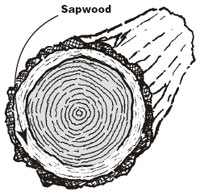
Square notch—A notch cut in a log to fit snugly against a square notch cut in another log, the square cut end of another log, or a plank. The portion of the notch in contact with the other log is cut as a flat, uniform plane. The end or ends of the square notch are perpendicular to the flat plane.

Setting bed—A layer of aggregate (either crushed stone or crushed gravel), or mason's sand, mortar placed on solid rock, or a compacted subgrade of existing ground or fill. Depending on the setting bed, material, and subsurface conditions, the setting bed may be from 4 to 12 inches deep.
Shim—A short, thin piece of wood, usually oak or redcedar, used between two pieces of wood or between a piece of wood and steel, earth, or rock. The shim is used to bring a ledger, stringer, or tread to level.
Slackwater—Floodwater with little or no velocity. Slackwater is formed when water in creeks, streams, and rivers backs up into low terrain, creating a temporary ponding condition.
Sleeper ß—A horizontal log or timber laid in a shallow trench to support a plank or logs.
Slope measurements—Measurements taken on the ground or parallel with the slope of the ground. Slope measurements provide a true indication of the quantities of materials needed for construction. Maps and construction drawings for roads and utility lines are measured horizontally. Measurements taken electronically are also measured horizontally. Slope measurements can sometimes be as much as 10 percent greater than horizontal measurements.
Sonotubes—Hollow cardboard cylinders used for forming round concrete columns. The sonotube is removed after the concrete sets.
Spalls—Small angular pieces of hard, durable stone. Spalls are wedged between stones that have been placed without mortar. Spalls have a function similar to that of shims used in wood construction.
Stringer—One of two or more beams placed parallel with the centerline of the tread that supports the tread plank.
Tamping—Using a narrow machine compactor, a tamping bar, the handle of a shovel, or other tool to compact earth backfill around a post, pole, or pile.
Test boring—A deep, narrow hole drilled into the ground with a power auger. A record is kept of the types of soils encountered and their depth. Test borings are usually done by geotechnical engineers (see test holes).
Test holes—Frequently, soil information does not require the sophistication and accuracy of test borings. A test hole can be dug by hand, or it can be dug with a backhoe. Test holes are wider than test borings, allowing the soil strata on the sides of the hole to be easily seen. Test holes can be no deeper than the equipment can easily and safely dig. The information provided by test holes is usually sufficient to determine construction techniques needed for wetland trails in areas where there is no previous wetland construction experience. It is simpler and cheaper to dig test holes than it is to drill test borings.
Timber—As used in this text, wood that has been sawed or hewed into a square or rectangular cross section that is at least 3 inches thick.
Toenail—Joining two pieces of wood by driving nails at an angle to the surface of one piece and into the second piece.

Tread—The walking surface of a trail. Applied to wetland trails constructed of wood, tread refers to the portion of the timber, log, or plank that the user steps on.
Twist—A defect in lumber and timber caused by a tree growing with a twisted grain. The result is a piece of lumber or timber with surfaces at one end that are not in the same plane as the surfaces at the other end. Occasionally, usable short lengths with little twist can be cut from the original piece. More commonly, the original piece is useless.

Wane—A defect in a piece of lumber or timber, caused by bark that was not removed or a beveled edge.
Waney edge—A term used at the sawmill to describe a board, plank, or timber of nonuniform width when one or two edges contain bark or irregular sapwood just below the bark. A waney edge is considered a defect, but the board or plank may be suitable for rustic construction.
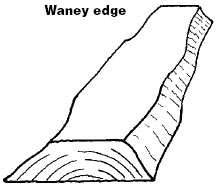
Warp—Severe bend in a piece of lumber or timber making it unusable in its original length. Sometimes the warp occurs mostly at one point, usually a knot, and short usable pieces can be cut on either side of that point.

Water table—The level below the ground surface where groundwater will fill a test hole.

Weir—A depressed channel in a dam providing an outlet for the overflow water in a pond when the water level exceeds a desired height. Weirs are usually concrete or timber, or a combination of the two.

Wetland indicator plants—Various species of plants that are tolerant of wet soils. When many specimens of these species are present at a site, they indicate a wetland environment.

